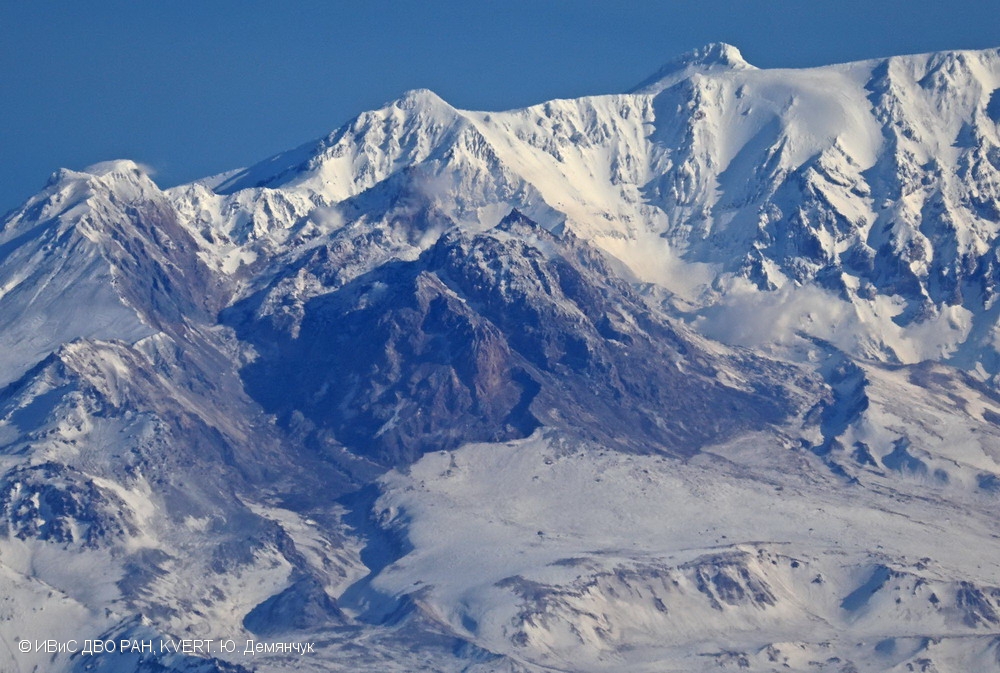Report on Sheveluch (Russia) — May 2018
Bulletin of the Global Volcanism Network, vol. 43, no. 5 (May 2018)
Managing Editor: Edward Venzke.
Research and preparation by Sara Arav-Piper.
Sheveluch (Russia) Intermittent thermal anomalies along with gas and steam emissions continue through April 2018
Please cite this report as:
Global Volcanism Program, 2018. Report on Sheveluch (Russia) (Venzke, E., ed.). Bulletin of the Global Volcanism Network, 43:5. Smithsonian Institution. https://doi.org/10.5479/si.GVP.BGVN201805-300270
Sheveluch
Russia
56.653°N, 161.36°E; summit elev. 3283 m
All times are local (unless otherwise noted)
An eruption at Sheveluch has been ongoing since 1999, and volcanic activity was previously described through January 2018 (BGVN 43:02). Ongoing activity has consisted of pyroclastic flows, explosions, and lava dome growth with a viscous lava flow in the N. According to the Kamchatka Volcanic Eruption Response Team (KVERT), moderate emissions of gas-and-steam have continued, and ash explosions up to 10-15 km in altitude could occur at any time. The Aviation Color Code remained at Orange (the second highest level on a four-color scale) throughout this reporting period from February through April 2018.
KVERT reported continuous moderate gas-and-steam plumes from Sheveluch during February-April 2018 (figure 49). Satellite imagery interpreted by KVERT showed a thermal anomaly over the volcano on 13 days during February, 21 days in March, and 15 days in April. Cloud cover obscured satellite imagery the remainder of the time during this reporting period.
 |
Figure 49. Photo of the lava dome at Sheveluch on 25 March 2018. Courtesy of Yu. Demyanchuk (IVS FEB RAS, KVERT). |
The MIROVA system detected intermittent low-power thermal anomalies from February through April 2018. Thermal anomalies, based on MODIS satellite instruments analyzed using the MODVOLC algorithm, were not detected during this period.
Geological Summary. The high, isolated massif of Sheveluch volcano (also spelled Shiveluch) rises above the lowlands NNE of the Kliuchevskaya volcano group. The 1,300 km3 andesitic volcano is one of Kamchatka's largest and most active volcanic structures, with at least 60 large eruptions during the Holocene. The summit of roughly 65,000-year-old Stary Shiveluch is truncated by a broad 9-km-wide late-Pleistocene caldera breached to the south. Many lava domes occur on its outer flanks. The Molodoy Shiveluch lava dome complex was constructed during the Holocene within the large open caldera; Holocene lava dome extrusion also took place on the flanks of Stary Shiveluch. Widespread tephra layers from these eruptions have provided valuable time markers for dating volcanic events in Kamchatka. Frequent collapses of dome complexes, most recently in 1964, have produced debris avalanches whose deposits cover much of the floor of the breached caldera.
Information Contacts: Kamchatka Volcanic Eruptions Response Team (KVERT), Far East Division, Russian Academy of Sciences, 9 Piip Blvd., Petropavlovsk-Kamchatsky, 683006, Russia (URL: http://www.kscnet.ru/ivs/kvert/); Institute of Volcanology and Seismology, Far Eastern Branch, Russian Academy of Sciences (IVS FEB RAS), 9 Piip Blvd., Petropavlovsk-Kamchatsky 683006, Russia (URL: http://www.kscnet.ru/ivs/eng/); Hawai'i Institute of Geophysics and Planetology (HIGP) - MODVOLC Thermal Alerts System, School of Ocean and Earth Science and Technology (SOEST), Univ. of Hawai'i, 2525 Correa Road, Honolulu, HI 96822, USA (URL: http://modis.higp.hawaii.edu/); MIROVA (Middle InfraRed Observation of Volcanic Activity), a collaborative project between the Universities of Turin and Florence (Italy) supported by the Centre for Volcanic Risk of the Italian Civil Protection Department (URL: http://www.mirovaweb.it/).

